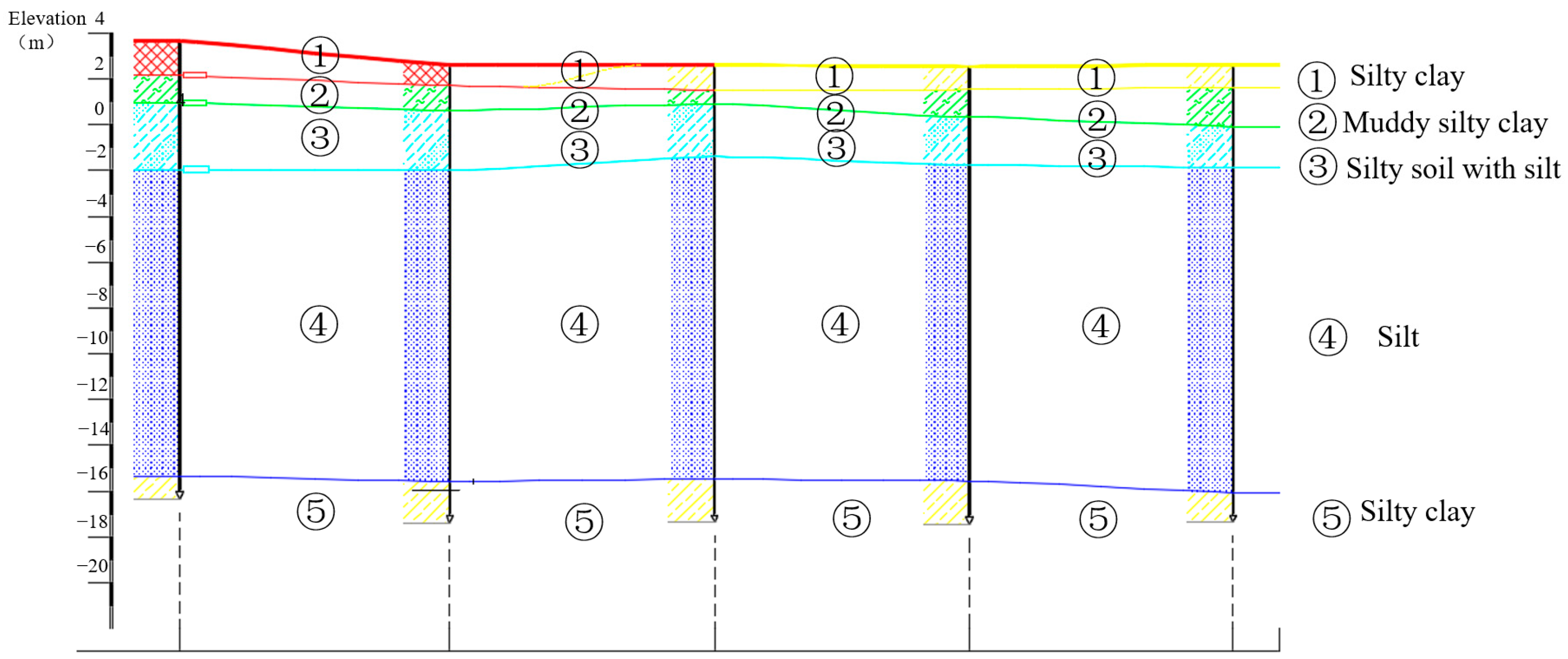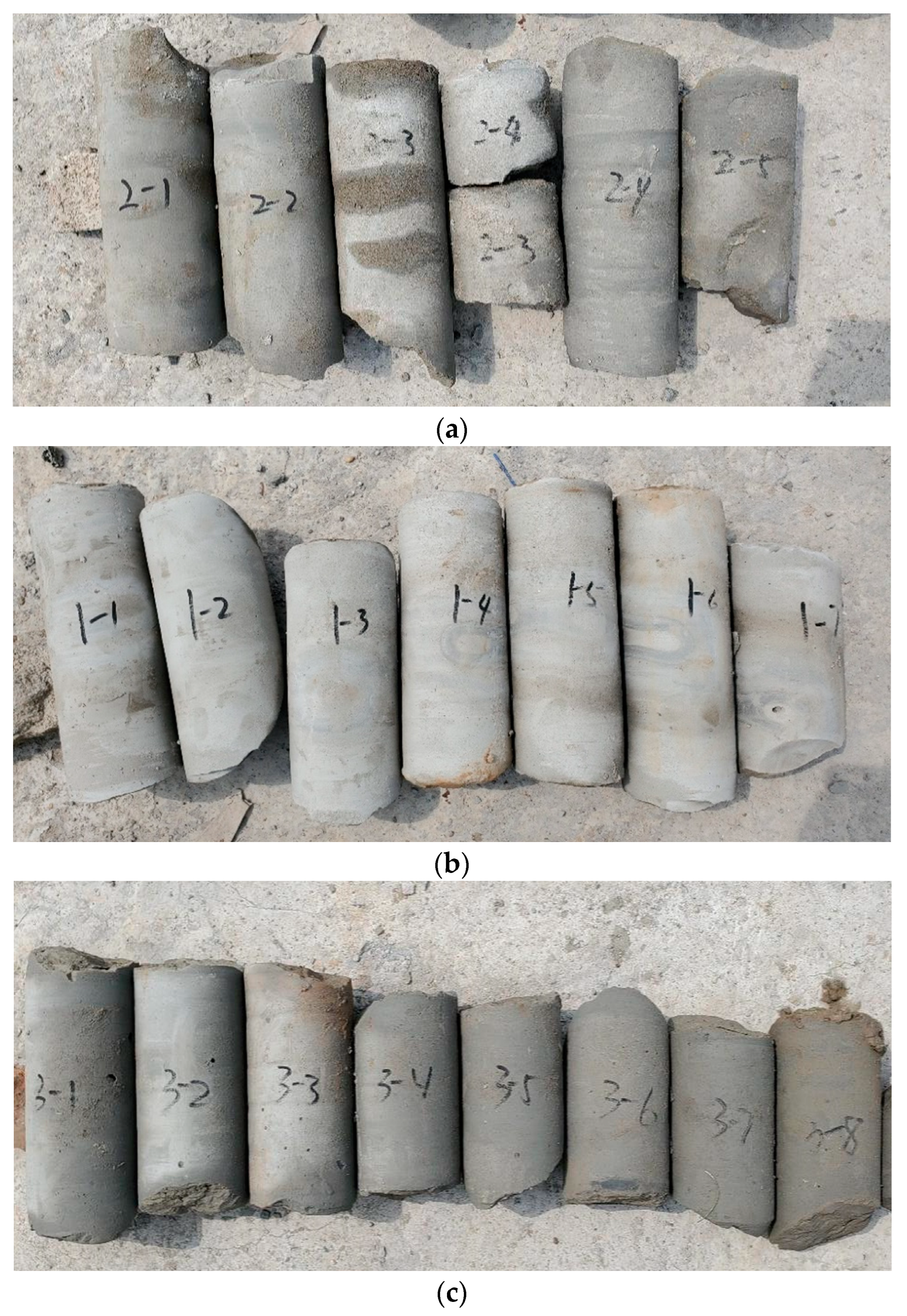Author Contributions
Conceptualization, P.Z.; methodology, P.Z. and S.W.; software, X.Q.; validation, S.W. and P.Z.; formal analysis, X.Q.; investigation, S.W.; resources, S.G.; data curation, S.G.; writing—original draft preparation, X.Q.; writing—review and editing, S.G. and P.Z.; visualization, S.G.; supervision, X.H.; project administration, P.Z.; funding acquisition, S.W. and X.Q. All authors have read and agreed to the published version of the manuscript.
Figure 1.
Geology of the place of study.
Figure 1.
Geology of the place of study.
Figure 2.
Types of additives. (a) High-polymer. (b) Red mud. (c) Metakaolin.
Figure 2.
Types of additives. (a) High-polymer. (b) Red mud. (c) Metakaolin.
Figure 3.
Solidification times of grouting fluids with OPC.
Figure 3.
Solidification times of grouting fluids with OPC.
Figure 4.
Solidification times with different ratios of group A and group B.
Figure 4.
Solidification times with different ratios of group A and group B.
Figure 5.
Solidification times with different ratios of high polymer and water.
Figure 5.
Solidification times with different ratios of high polymer and water.
Figure 6.
Solidification times with different ratios of cement, red mud and phosphogypsum.
Figure 6.
Solidification times with different ratios of cement, red mud and phosphogypsum.
Figure 7.
Effect of the ratio on the solidification aging of MKCG.
Figure 7.
Effect of the ratio on the solidification aging of MKCG.
Figure 8.
Permeability coefficient of cement–soil with different contents of cement.
Figure 8.
Permeability coefficient of cement–soil with different contents of cement.
Figure 9.
Permeability coefficients of HPCG.
Figure 9.
Permeability coefficients of HPCG.
Figure 10.
Permeability coefficients of RPCG.
Figure 10.
Permeability coefficients of RPCG.
Figure 11.
Permeability coefficients of MKCG with different cement to metakaolin ratios.
Figure 11.
Permeability coefficients of MKCG with different cement to metakaolin ratios.
Figure 12.
Framework of the information monitoring system of jet grouting.
Figure 12.
Framework of the information monitoring system of jet grouting.
Figure 13.
Installation of monitoring sensors. (a) Flowmeter. (b) Speed sensor. (c) Depth sensor. (d) Pressure sensor.
Figure 13.
Installation of monitoring sensors. (a) Flowmeter. (b) Speed sensor. (c) Depth sensor. (d) Pressure sensor.
Figure 14.
The operating system for the double fluid jet grouting system. (a) Interface. (b) Setup menu. (c) Working monitor. (d) Data history.
Figure 14.
The operating system for the double fluid jet grouting system. (a) Interface. (b) Setup menu. (c) Working monitor. (d) Data history.
Figure 15.
On-site mixing of modified cement grouting materials. (a) HPCG. (b) RPCG. (c) MKCG.
Figure 15.
On-site mixing of modified cement grouting materials. (a) HPCG. (b) RPCG. (c) MKCG.
Figure 16.
Information monitoring data during construction of test columns. (a) HPCG. (b) RPCG. (c) MKC.
Figure 16.
Information monitoring data during construction of test columns. (a) HPCG. (b) RPCG. (c) MKC.
Figure 17.
Excavation site of test piles.
Figure 17.
Excavation site of test piles.
Figure 18.
Core sampling of site tests. (a) HPCG. (b) RPCG. (c) MKCG.
Figure 18.
Core sampling of site tests. (a) HPCG. (b) RPCG. (c) MKCG.
Figure 19.
Round table samples of permeability coefficient tests. (a) HPCG. (b) RPCG. (c) MKCG.
Figure 19.
Round table samples of permeability coefficient tests. (a) HPCG. (b) RPCG. (c) MKCG.
Figure 20.
SEM results of test columns. (a) HPCG. (b) RPCG. (c) MKCG.
Figure 20.
SEM results of test columns. (a) HPCG. (b) RPCG. (c) MKCG.
Figure 21.
Comparison of permeability coefficients of in situ tests with laboratory tests at 28 days.
Figure 21.
Comparison of permeability coefficients of in situ tests with laboratory tests at 28 days.
Table 1.
Physical indexes of the silt.
Table 1.
Physical indexes of the silt.
| Sampling Depth (m) | Specific Gravity | Saturation Density (g/cm3) | Dry Density (g/cm3) | Void Ratio | Liquid Limit (%) | Plastic Limit (%) | Plasticity Index (%) | Liquid Index (%) |
|---|
| 3.8~4.0 | 2.69 | 1.94 | 1.52 | 0.760 | 33.6 | 22.6 | 7.0 | 0.67 |
| 4.8~5.0 | 2.68 | 1.94 | 1.52 | 0.759 |
| 6.8~7.0 | 2.68 | 2.00 | 1.58 | 0.691 |
| 9.8~10 | 2.68 | 1.94 | 1.44 | 0.864 |
| 11.3~11.5 | 2.68 | 1.93 | 1.44 | 0.856 |
Table 2.
Permeability coefficients of the silt.
Table 2.
Permeability coefficients of the silt.
| Sampling Depth (m) | Vertical Permeability Coefficient (10−3cm/s) | Horizontal Permeability Coefficient (10−3cm/s) |
|---|
| 3.8~4.0 | 1.85 | 3.76 |
| 4.8~5.0 | 4.12 | 7.48 |
| 6.8~7.0 | 2.64 | 5.13 |
| 9.8~10.0 | 1.76 | 3.25 |
| 11.3~11.5 | 2.14 | 3.62 |
Table 3.
Chemical composition of metakaolin and red mud.
Table 3.
Chemical composition of metakaolin and red mud.
| Metakaolin | Chemical composition | SiO2 | Al2O3 | Fe2O3 | CaO | MgO | K2O | Na2O | SO3 | TiO2 |
| Proportion/% | 57.16 | 37.7 | 1.28 | 0.13 | 0.09 | 0.55 | 0.01 | 0.01 | 3.06 |
| Red mud | Chemical composition | SiO2 | Al2O3 | Fe2O3 | CaO | MgO | Na2O | SO3 | TiO2 | Others |
| Proportion/% | 26.71 | 23.7 | 5.82 | 15.56 | 1.13 | 6.15 | 3.51 | 3.36 | 14.06 |
Table 4.
Chemical composition of ordinary Portland cement.
Table 4.
Chemical composition of ordinary Portland cement.
| CaO | SiO2 | Al2O3 | Fe2O3 | SO | MgO | F-CaO | Loss on Ignition |
|---|
| 57.22 | 23.19 | 8.61 | 4.08 | 1.93 | 1.04 | 1.37 | 2.56 |
Table 5.
Proportion of test columns.
Table 5.
Proportion of test columns.
| Grouting Material | Mass of Each Component/kg |
|---|
| HPCG | Group A | Group B | Cement | Water |
| 15 | 7.5 | 100 | 100 |
| RPCG | Red mud | Phosphogypsum | Cement | Water |
| 35 | 5 | 80 | 100 |
| MKCG | Metakaolin | Cement | Water |
| 20 | 100 | 100 |
Table 6.
Permeability coefficients of HPCG.
Table 6.
Permeability coefficients of HPCG.
| Case ID | Seepage Pressure/(kPa) | Permeability Coefficient/(cm/s) | Average Permeability Coefficient/(cm/s) |
|---|
| HPCG-1 | 300 | 7.27 × 10−8 | 2.61 × 10−7 |
| HPCG-2 | 300 | 6.50 × 10−8 |
| HPCG-3 | 500 | 2.34 × 10−7 |
| HPCG-4 | 500 | 1.87 × 10−7 |
| HPCG-5 | 500 | 6.45 × 10−7 |
| HPCG-6 | 500 | 1.13 × 10−7 |
| HPCG-7 | 300 | 5.14 × 10−7 |
Table 7.
Permeability coefficients of RPCG.
Table 7.
Permeability coefficients of RPCG.
| Case ID | Seepage Pressure/(kPa) | Permeability Coefficient/(cm/s) | Average Permeability Coefficient/(cm/s) |
|---|
| RPCG-1 | 600 | 4.23 × 10−6 | 2.7 × 10−6 |
| RPCG-2 | 1000 | 1.20 × 10−6 |
| RPCG-3 | 500 | 1.49 × 10−6 |
| RPCG-4 | 500 | 2.08 × 10−6 |
| RPCG-5 | 500 | 1.48 × 10−6 |
Table 8.
Permeability coefficients of MKCG.
Table 8.
Permeability coefficients of MKCG.
| Case ID | Seepage Pressure/(kPa) | Permeability Coefficient/(cm/s) | Average Permeability Coefficient/(cm/s) |
|---|
| MKCG-1 | 200 | 3.09 × 10−6 | 3.31 × 10−6 |
| MKCG-2 | 200 | 3.08 × 10−6 |
| MKCG-3 | 1000 | 2.42 × 10−6 |
| MKCG-4 | 500 | 3.68 × 10−6 |
| MKCG-5 | 500 | 4.28 × 10−6 |






























